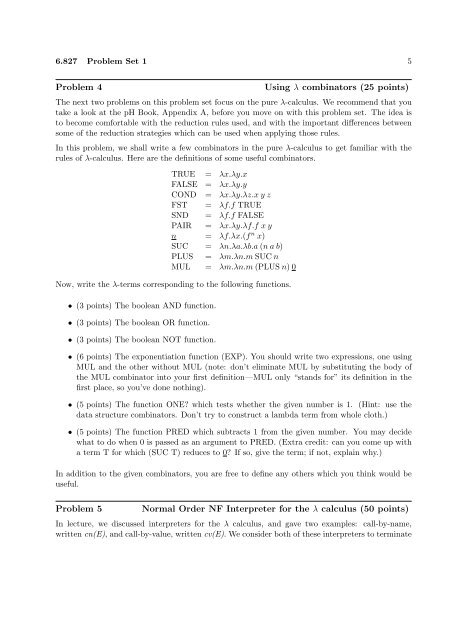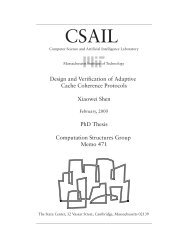Problem Set 1 - Computation Structures Group - MIT
Problem Set 1 - Computation Structures Group - MIT
Problem Set 1 - Computation Structures Group - MIT
Create successful ePaper yourself
Turn your PDF publications into a flip-book with our unique Google optimized e-Paper software.
6.827 <strong>Problem</strong> <strong>Set</strong> 1 5<br />
<strong>Problem</strong> 4 Using λ combinators (25 points)<br />
The next two problems on this problem set focus on the pure λ-calculus. We recommend that you<br />
take a look at the pH Book, Appendix A, before you move on with this problem set. The idea is<br />
to become comfortable with the reduction rules used, and with the important differences between<br />
some of the reduction strategies which can be used when applying those rules.<br />
In this problem, we shall write a few combinators in the pure λ-calculus to get familiar with the<br />
rules of λ-calculus. Here are the definitions of some useful combinators.<br />
TRUE = λx.λy.x<br />
FALSE = λx.λy.y<br />
COND = λx.λy.λz.x y z<br />
FST = λf.f TRUE<br />
SND = λf.f FALSE<br />
PAIR = λx.λy.λf.f x y<br />
n = λf.λx.(f n x)<br />
SUC = λn.λa.λb.a (n a b)<br />
PLUS = λm.λn.m SUC n<br />
MUL = λm.λn.m (PLUS n) 0<br />
Now, write the λ-terms corresponding to the following functions.<br />
• (3 points) The boolean AND function.<br />
• (3 points) The boolean OR function.<br />
• (3 points) The boolean NOT function.<br />
• (6 points) The exponentiation function (EXP). You should write two expressions, one using<br />
MUL and the other without MUL (note: don’t eliminate MUL by substituting the body of<br />
the MUL combinator into your first definition—MUL only “stands for” its definition in the<br />
first place, so you’ve done nothing).<br />
• (5 points) The function ONE? which tests whether the given number is 1. (Hint: use the<br />
data structure combinators. Don’t try to construct a lambda term from whole cloth.)<br />
• (5 points) The function PRED which subtracts 1 from the given number. You may decide<br />
what to do when 0 is passed as an argument to PRED. (Extra credit: can you come up with<br />
a term T for which (SUC T) reduces to 0? If so, give the term; if not, explain why.)<br />
In addition to the given combinators, you are free to define any others which you think would be<br />
useful.<br />
<strong>Problem</strong> 5 Normal Order NF Interpreter for the λ calculus (50 points)<br />
In lecture, we discussed interpreters for the λ calculus, and gave two examples: call-by-name,<br />
written cn(E), and call-by-value, written cv(E). We consider both of these interpreters to terminate
















